Key takeaways:
- Dress alterations can transform off-the-rack garments, enhancing personal style and emotional connection.
- Effective communication with your tailor is crucial, including discussing specific adjustments and sharing visuals for clarity.
- Proper preparation and care for your dress before and after alterations ensure the best fit and longevity of the garment.
- Choosing a trusted tailor with experience, a good rapport, and clear communication improves the alteration experience significantly.
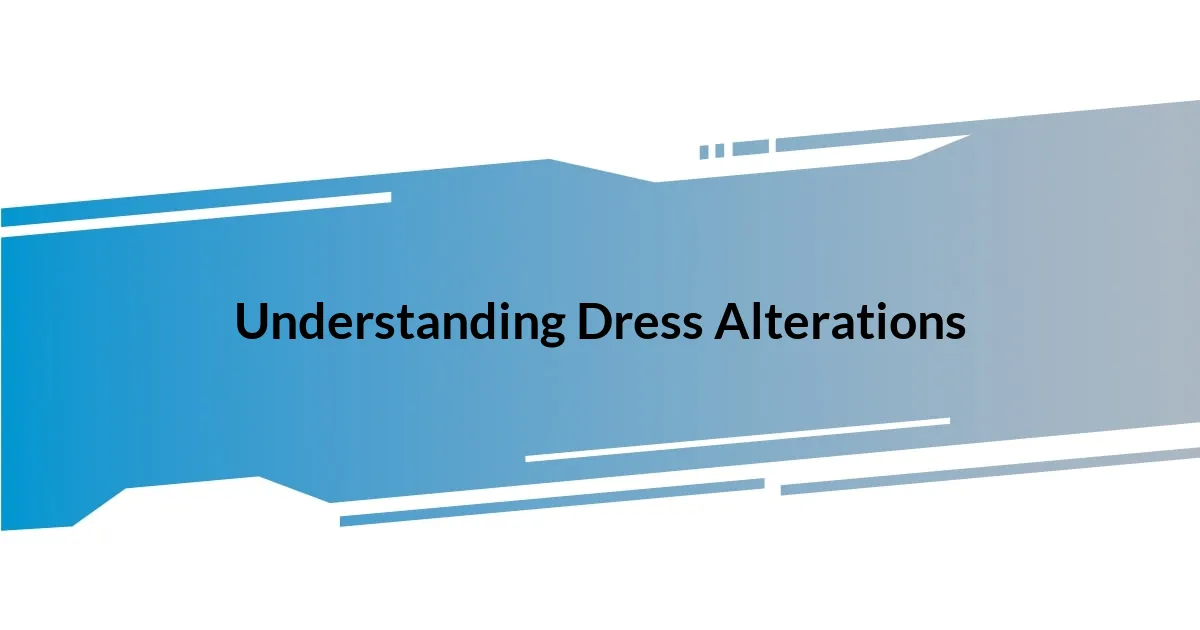
Understanding Dress Alterations
Understanding dress alterations can feel a bit overwhelming at first, but I believe it’s all about recognizing its transformative power. The right alterations can take an off-the-rack garment and turn it into something uniquely yours. Have you ever slipped into a dress that just fit perfectly? That joy is what alterations can bring.
When I first ventured into dress alterations, I remember my excitement mixed with a hint of nervousness. It felt like an adventure, stepping into a tailor’s space filled with fabric swatches and sewing machines, where magic happens. Isn’t it fascinating how a skilled eye can envision potential just by looking at a dress? I’ve learned the importance of communication with the tailor; they need to understand not just your measurements but also your style aspirations.
Each alteration, whether it’s taking in the sides or shortening the hem, can evoke emotions tied to memories linked to that dress. I’ve had a cherished family dress altered for a special occasion, and the experience was both sentimental and empowering. It made me appreciate how alterations are not just practical; they’re a way to honor the stories woven into the fabric. So, what dress in your collection could use a little extra love?
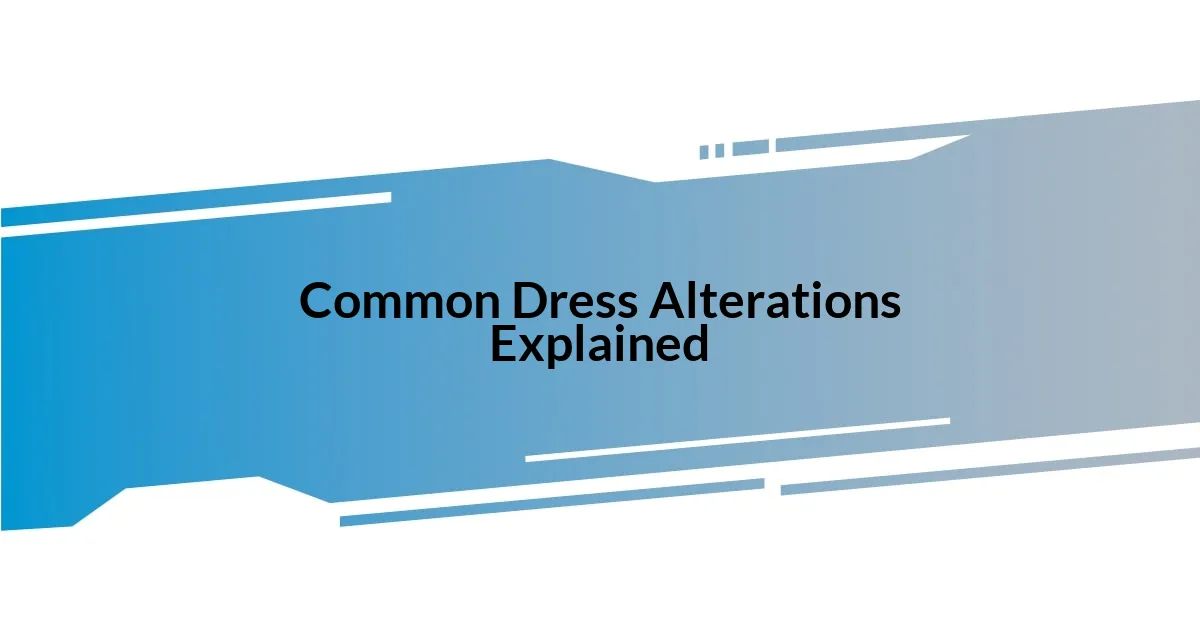
Common Dress Alterations Explained
When it comes to common dress alterations, a few stand out for their versatility and impact. Taking in the sides is a popular alteration, often necessary for achieving that snug fit. I recall working with a vintage dress that I adored; it had all the right elements, but the fit around the waist was a bit loose. Once the sides were taken in, it felt like I was wearing a tailored masterpiece that hugged my curves just right.
Another frequent alteration is shortening the hem. I vividly remember a beautiful maxi dress I bought for a summer wedding; it was breathtaking but dragged on the ground when I walked. After a quick hem adjustment, not only was I able to dance freely, but it also added an air of elegance to my overall look. The difference was astounding, and it reinforced just how critical the length can be for overall ensemble balance.
Lastly, replacing a zipper may not sound glamorous, but it’s essential when a dress becomes too tight or simply out of style. I’ve had a favorite dress with a broken zipper hiding in my closet for years. When I finally decided to have it replaced, it felt like reuniting with an old friend. Not only did it allow me to wear it again, but it also breathed new life into a piece I thought was beyond salvation.
| Alteration Type | Description |
|---|---|
| Taking in the sides | Reduces fabric at the waist and sides for a tailored fit. |
| Shortening the hem | Adjusts the length of the dress, ensuring it falls at the desired point. |
| Replacing a zipper | Replaces or repairs a zipper that is stuck, broken, or outdated. |
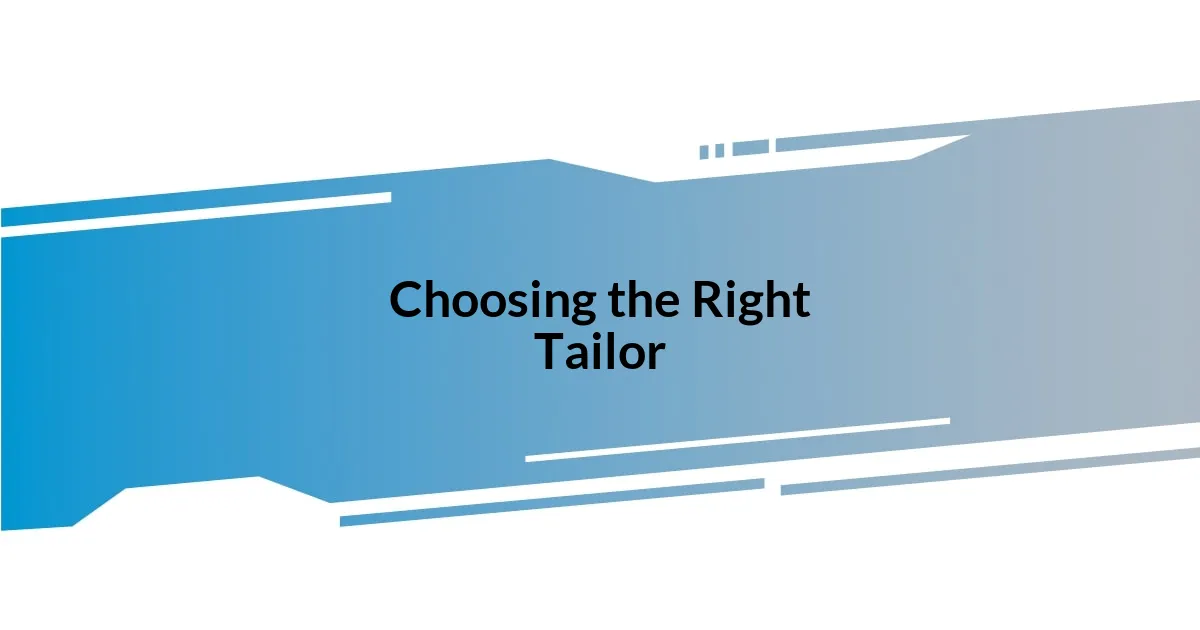
Choosing the Right Tailor
When it comes to selecting the right tailor, I can’t stress enough the importance of finding someone you trust. Your tailor is your partner in creating the perfect fit, and that requires a strong rapport. I remember my first visit to a new tailor; their warm demeanor immediately put me at ease, and I left feeling confident in their abilities. A good tailor listens to your needs and makes you feel valued, which is crucial for a successful alteration experience.
Here are some key considerations when choosing a tailor:
- Experience with Specific Styles: Make sure they have experience with the kind of dress you want altered, whether it’s formal, casual, or vintage.
- Portfolio: Look for a portfolio or pictures of previous work. This can give you insight into their skill level and style.
- Communication Skills: Pay attention to how they listen and respond to your requests. Clear communication is essential.
- Reviews and Recommendations: Seek out reviews from others or ask friends for recommendations to ensure you pick someone reputable.
- Comfort Level: Trust your instincts. Feeling comfortable and confident with your tailor can make a big difference in the outcome.
Finding the right tailor is a journey I’ve embraced each time I have a dress altered. One time, I took a chance on a new tailor because of a friend’s glowing recommendation. As she carefully pinned the fabric, we chatted about my vision, and I felt an instant connection. It turned out to be an incredible transformation that exceeded my expectations. A tailor who truly understands you can elevate your dress into something you’ll cherish for years.
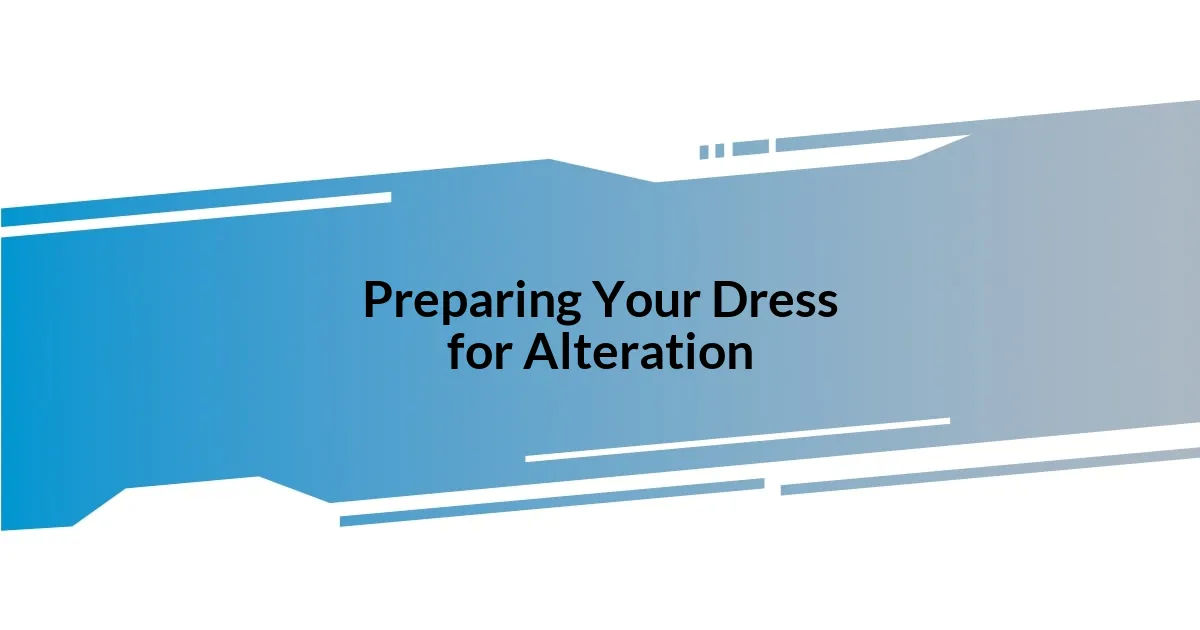
Preparing Your Dress for Alteration
Before you take your dress to the tailor, it’s essential to prepare it properly. First, I recommend trying on the dress and marking any areas that feel a bit off. A couple of times, I’ve jotted down notes or taken pictures on my phone, allowing me to remember specific adjustments I wanted. This preparation helps both you and the tailor understand your vision clearly.
One tip that’s saved me from potential mishaps is to wear the undergarments and shoes you plan to wear with the dress during your fitting. I remember a time I had a lovely evening gown altered without the appropriate heels, and I ended up with a hem that was just a tad too long. Ensuring everything is in place gives the tailor a better idea of how the dress should look and fit in real life.
Lastly, don’t forget to clean your dress ahead of time, especially if it’s been worn before. I learned this lesson the hard way when I brought a dress for alterations, only to discover a tiny stain that had gone unnoticed. Not only did it put a damper on the fitting, but it also delayed the alteration process. A clean slate not only makes the dress look its best but also shows respect for the tailor’s time and expertise.
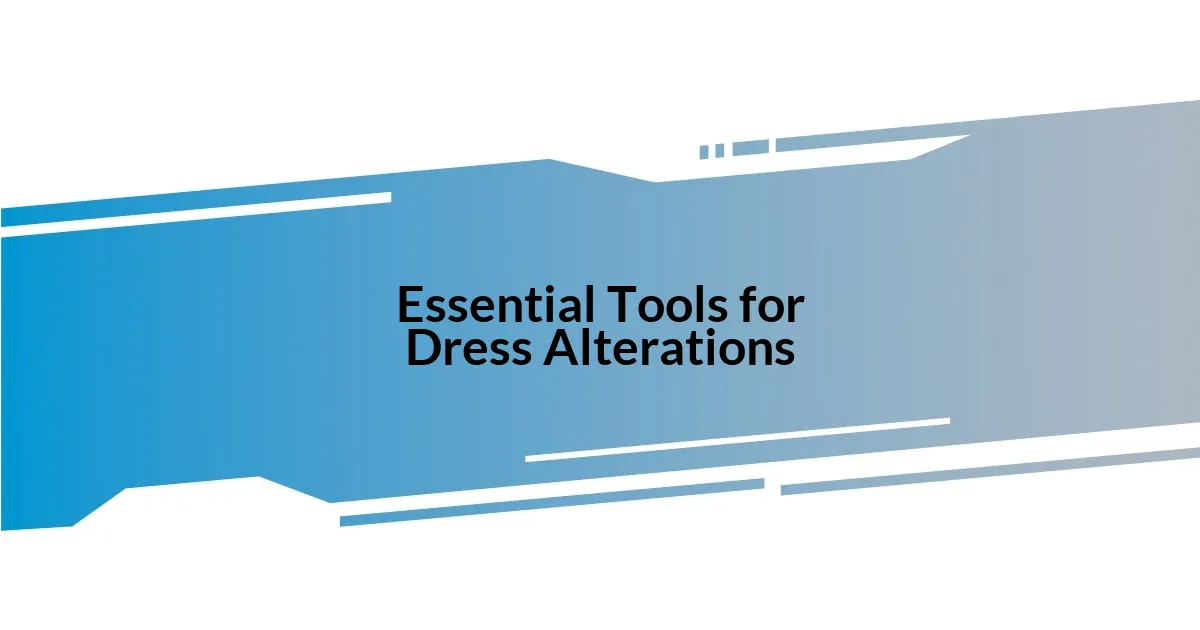
Essential Tools for Dress Alterations
Essential Tools for Dress Alterations
When it comes to dress alterations, having the right tools is key to achieving a professional finish. I usually start with a reliable pair of fabric scissors; these can make all the difference, ensuring clean cuts without damaging the material. I’ve experienced the frustration of using dull scissors and the ragged hems that resulted, which made me appreciate this essential tool even more.
A quality measuring tape is another must-have. I remember my early days of sewing, measuring twice, sometimes thrice, to avoid any mishaps. It’s amazing how a simple measurement can change the entire feel of a garment, and I always double-check my numbers to ensure everything aligns perfectly. Do you think it makes sense to invest in a retractable tape? Trust me, it can save so much time and hassle during the alteration process.
Finally, don’t underestimate the power of pins. I have a colorful array of them that I use to hold fabric in place while I work. Once, I was so excited about altering a vintage dress that I skipped this step and ended up with uneven seams. Now, I always take the time to secure everything before making any permanent changes. It’s such a small tool but plays a huge role in achieving that immaculate look we all want.
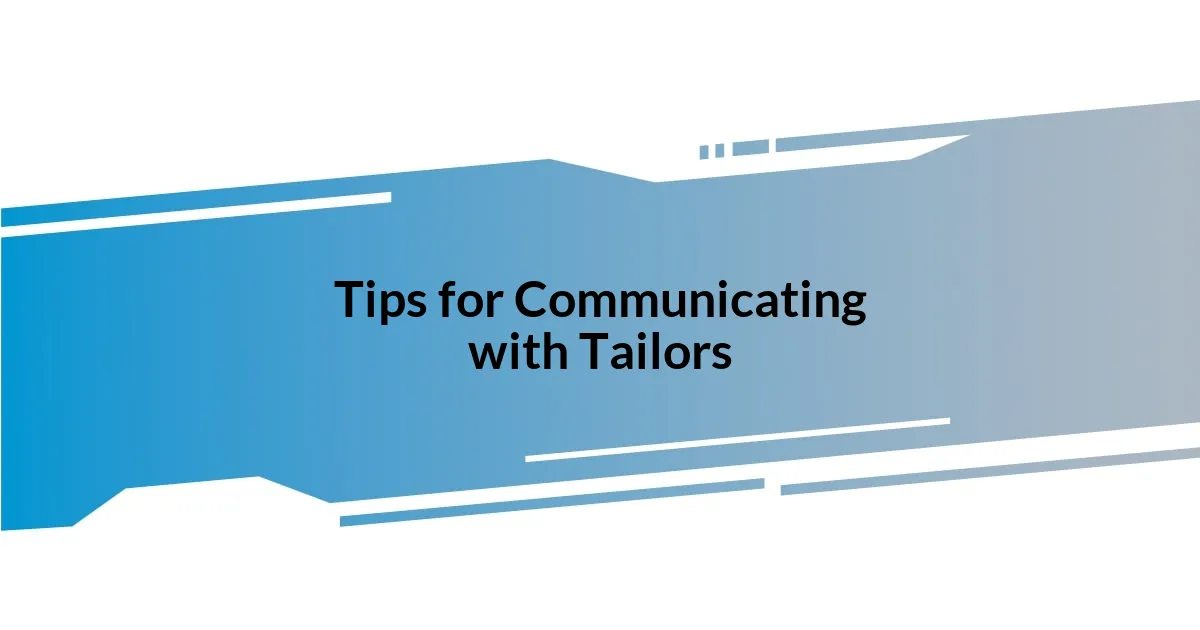
Tips for Communicating with Tailors
Communicating with your tailor effectively can make a significant difference in the outcome of your alterations. I often start by explaining my vision in detail, using any visuals like magazine clippings or inspiration photos. It’s fascinating how sharing a simple picture can spark a conversation that leads to an even better result than I initially imagined. Have you ever shown someone a picture and they understood your idea perfectly? It’s like a lightbulb moment!
When discussing specific adjustments, I’ve learned that being direct and honest is crucial. During a fitting for a wedding dress, I hesitated to mention that I wanted a tighter fit. However, once I opened up, it made the process smoother and ultimately resulted in a dress that made me feel confident and comfortable. I usually ask my tailor for their professional opinion, too. Their expertise often reveals options I hadn’t considered, which can bring my original idea to life in a way that sparks joy.
Lastly, I’ve found it’s helpful to establish a friendly rapport with my tailor. Simply asking about their experiences or sharing a laugh can create a more enjoyable atmosphere. One time, a light-hearted conversation about a particularly challenging garment we were working on turned into a collaborative brainstorming session. It reminded me how important it is to connect personally—it not only eases the stress of alterations but strengthens the likelihood of achieving the perfect fit. Have you noticed how a friendly interaction can lead to better outcomes in any collaboration? It’s all about teamwork!
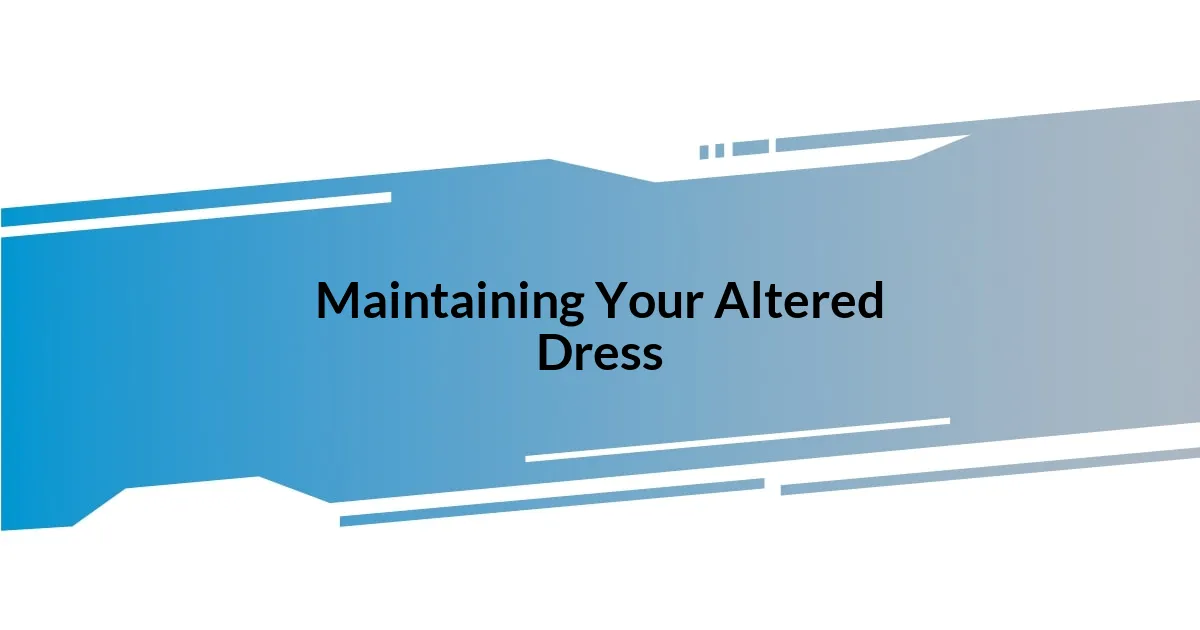
Maintaining Your Altered Dress
Caring for an altered dress is essential to keep it looking pristine. I remember the first time I spilled something on a freshly altered gown. The panic that set in made me realize how important it is to treat these garments delicately. Always check the care label for specific cleaning instructions, as the fabric type can make a huge difference. Do you have a favorite stain remover on hand? I always keep one nearby, just in case.
Storage also plays a significant role in maintaining your dress. After wearing a beloved piece, I make sure to hang it properly—preferably using padded hangers to prevent those pesky hanger marks. Once, I tucked a dress away in a drawer, only to find crinkles and creases that took ages to iron out. It’s a small effort that pays off when you reach for your outfit again and it’s ready to shine.
Lastly, regular inspections can save you from future mishaps. I developed a habit of checking seams and hems every few months. One time, I found a tiny thread unraveling on a dress that I’d love to wear for an upcoming occasion. If I had waited longer, it could’ve turned into a much bigger issue. Have you ever caught a problem early and felt that wave of relief? Taking the time to look over your alterations can ensure that they remain beautiful for many occasions to come.